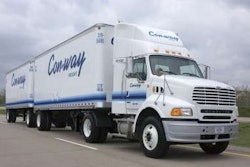When Daimler Trucks North America announced in December 2006 it would build a Class 8 truck manufacturing plant in Saltillo, Mexico, the company wanted the additional capacity to meet demand it couldn’t meet at the time. Now that the plant is open, the truck maker has ample capacity but few customers to take trucks it produces in the current economic collapse.
Last week, DTNA officially opened the 1.3 million-square-foot plant on 740 acres in northern Mexico, about 250 miles from the Texas border. The state-of-the-art plant has capacity to build 30,000 heavy-duty trucks annually. The current daily output of eight is expected to increase to 12 to 15 a day by April.
The factory was designed to accommodate production of Freightliner Cascadia and Sterling heavy-duty trucks, but DTNA pulled the plug on the Sterling brand last October. Consequently, the plant, designed with the latest innovations from Daimler, has plenty of capacity for growth when the North American truck market rebounds.
When in full production over two shifts, the plant will employ about 1,600 line personnel and managers. Currently, about one-third that many are working on a single shift. In a public-private partnership with the Mexican federal and local government, Daimler invested $300 million in the plant to be ready when the market turns.
“We know we won’t see volumes like those this industry experienced in 2005 and 2006 any time in the next three or four years, maybe longer,” says Chris Patterson, president and chief executive officer. “When all is said and done, the strategy for the decision to create Saltillo has not changed – in fact, quite the opposite. The new Saltillo plant will make DTNA stronger and more competitive.”
In seeking to develop a “benchmark” plant, DTNA drew collaboration from staffers in Germany, Japan, the United States and Mexico. The new plant’s production is set up as “TOS – truck operating system,” with the goal of emphasizing quality at every work station, sharing best practices and training methods, and aiming for continuous improvement, says Andreas Renschler, head of Daimler Trucks in Germany. Employees underwent longer-than-normal training, which included such exercises as assembling toy trucks with Legos.
The Saltillo plant joins DTNA’s Santiago Tianguistenco plant near Mexico City, giving the company the capacity to produce 60,000 heavy-duty and medium-duty trucks south of the border. That will account for almost 40 percent of DTNA’s manufacturing capacity of 160,000 trucks after the company’s Portland facility closes in July 2010.
More than 100 truck and auto parts suppliers are located in the area, and DTNA is recruiting to attract its other truck component suppliers with the help of the Mexican government. The local government helped arrange the land purchase and is working on developing a “supplier park, which will bring our suppliers closer to us,” says Roger Nielsen, DTNA chief operation officer.
Renschler says Daimler built plants in Santiago and Saltillo because Mexico is a growing market and is close to the United States. “In a very competitive environment, where can you put the most efficient production?” he says.
Nielsen says labor costs are lower in Mexico, but that is offset partially by higher fuel costs in transporting vehicles to the United States and Canada. At the peak of the market, DTNA bought about $600 million worth of materials in Mexico, and aims to triple that over the next four years, he says.
Initial production of Saltillo Cascadias will go to the United States and Canada, while the model will be introduced to the Mexican market later this year. Asked if the “made in Mexico” label will hurt resale value, Patterson says the stigma of Mexican commercial manufacturing has long passed.













